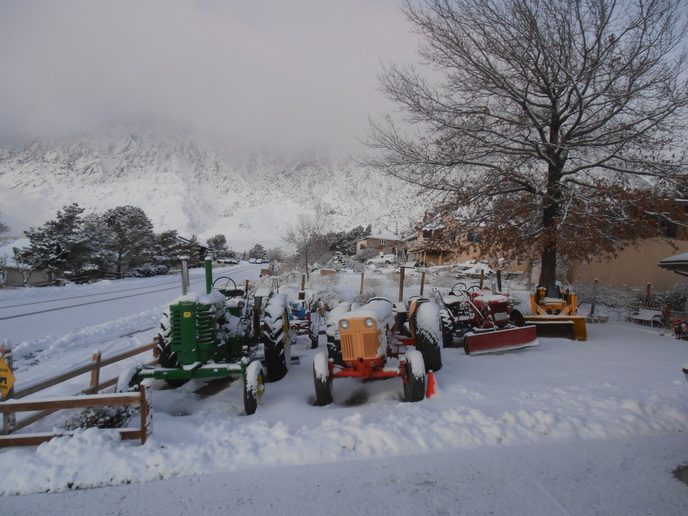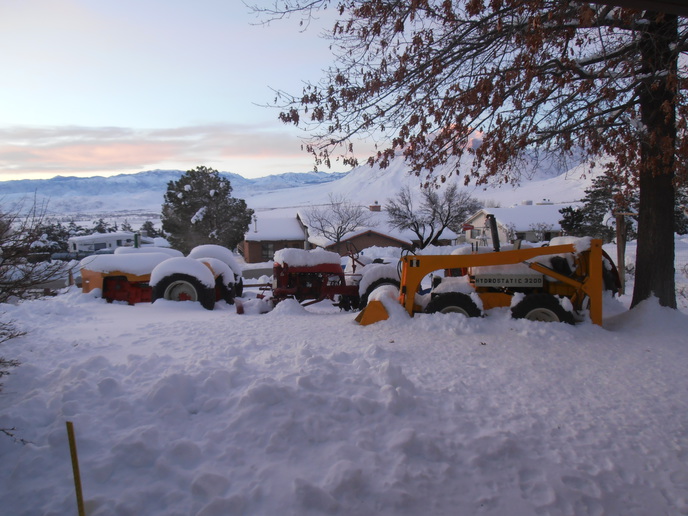Henrik Jansson
Member
I will reassemble my Case 1370 with a "new" power shift carrier.
This will affect the preload of the bearings on the pinion shaft.
I do not want to remove the differantial and everything so I will try to do like this:
I have spent a few hours now to assembling it exactly as it sat before, ( and you do it , you should not think about anything else accordning to the Repair Manual ) . But then I will of course replace a part that makes the distance between the bearings can potentially affected.
The first picture here shows how the nut will sit. Before I pulled as far as I pulled short pieces at a time and felt thoroughly after if I could feel any looseness , by prying the shaft against me , and push back . I also tried to poke on the rolls in the bearings to know when they started to impose themselves .
After swerving back and forth several times and also mounted loose layer and sat there again , I concluded each time that when I had pulled nut as far as the second picture, I could not feel any looseness when I pushed the shaft forward. The shaft is 49 mm in diameter, the track can be seen in the shaft is 8 mm wide . I filed a mark straight over the nut , you look in the lower right corner to the mark on the first image is aligned with the edge of the groove in the shaft. This is where the nut should be in this case , as it sat in place.
After many repeated tests , I concluded that the gap could be felt when mark sat at the top corner on the track, then when the nut was tightened 8 mm less ( or 1/19 laps less and with a pitch of about 1.3 mm / rev , therefore 0,07 mm less. )
I also found repeatedly that the gap disappears when it is taken 6.5-7 mm tightening the nut. ( What you see on the second picture)
So then , I will mount the new power shift carrier. Besides , all parts are the same .
Then , I look up this situation where the gap disappears , and then drag 6.5mm longer .
It ought to work?
Since that I have been up to the gap ends at precisely this point several times, with a margin of error of 0.5 mm ( of 153 mm circumference) so should surely this method good enough ?
If I do then the same procedure at the new reassembly and manage to find the point where the gap disappears repeatedly then it should well be right ?
I have pried shaft forward and even knocked it a bit.
But one thing I'm thinking a little on .. because it's an old tractor from 1976 that has gone over 5000 hours , one can expect that the roller bearing is a bit worn so that it would possibly tighten a little more than it was when you took it apart ?
Since there is a little gap between the pinion and the differential, would it be possible to measure the rolling torque for this 1/50 revolution? And what should it be?


This will affect the preload of the bearings on the pinion shaft.
I do not want to remove the differantial and everything so I will try to do like this:
I have spent a few hours now to assembling it exactly as it sat before, ( and you do it , you should not think about anything else accordning to the Repair Manual ) . But then I will of course replace a part that makes the distance between the bearings can potentially affected.
The first picture here shows how the nut will sit. Before I pulled as far as I pulled short pieces at a time and felt thoroughly after if I could feel any looseness , by prying the shaft against me , and push back . I also tried to poke on the rolls in the bearings to know when they started to impose themselves .
After swerving back and forth several times and also mounted loose layer and sat there again , I concluded each time that when I had pulled nut as far as the second picture, I could not feel any looseness when I pushed the shaft forward. The shaft is 49 mm in diameter, the track can be seen in the shaft is 8 mm wide . I filed a mark straight over the nut , you look in the lower right corner to the mark on the first image is aligned with the edge of the groove in the shaft. This is where the nut should be in this case , as it sat in place.
After many repeated tests , I concluded that the gap could be felt when mark sat at the top corner on the track, then when the nut was tightened 8 mm less ( or 1/19 laps less and with a pitch of about 1.3 mm / rev , therefore 0,07 mm less. )
I also found repeatedly that the gap disappears when it is taken 6.5-7 mm tightening the nut. ( What you see on the second picture)
So then , I will mount the new power shift carrier. Besides , all parts are the same .
Then , I look up this situation where the gap disappears , and then drag 6.5mm longer .
It ought to work?
Since that I have been up to the gap ends at precisely this point several times, with a margin of error of 0.5 mm ( of 153 mm circumference) so should surely this method good enough ?
If I do then the same procedure at the new reassembly and manage to find the point where the gap disappears repeatedly then it should well be right ?
I have pried shaft forward and even knocked it a bit.
But one thing I'm thinking a little on .. because it's an old tractor from 1976 that has gone over 5000 hours , one can expect that the roller bearing is a bit worn so that it would possibly tighten a little more than it was when you took it apart ?
Since there is a little gap between the pinion and the differential, would it be possible to measure the rolling torque for this 1/50 revolution? And what should it be?





